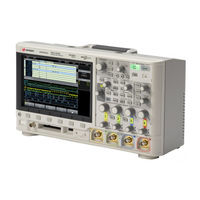Keysight DSOX3052T Oscilloscope Manuals
Manuals and User Guides for Keysight DSOX3052T Oscilloscope. We have 1 Keysight DSOX3052T Oscilloscope manual available for free PDF download: User Manual
Keysight DSOX3052T User Manual (530 pages)
InfiniiVision 3000T X-Series
Brand: Keysight
|
Category: Test Equipment
|
Size: 9.42 MB
Table of Contents
-
-
-
Drag Cursors51
-
-
XY Time Mode68
-
-
FFT Units95
-
FFT DC Value95
-
FFT Aliasing95
-
Math Operators102
-
Add or Subtract102
-
-
Math Transforms104
-
Differentiate105
-
Integrate106
-
Square Root113
-
Ax + B114
-
Square115
-
Absolute Value115
-
Common Logarithm116
-
Exponential117
-
-
Math Filters118
-
Averaged Value119
-
Smoothing120
-
Envelope120
-
-
Magnify121
-
Maximum/Minimum122
-
Peak-Peak122
-
Max/Min Hold122
-
-
Digital Channels131
-
-
Input Impedance143
-
Probe Grounding145
-
Serial Decode149
-
-
Lister151
-
-
Display Settings156
-
-
10 Labels161
-
Triggers170
-
Edge Trigger172
-
Pattern Trigger178
-
OR Trigger181
-
Runt Trigger188
-
Video Trigger191
-
Serial Trigger203
-
-
Control216
-
-
Cursor Examples237
-
-
Snapshot All249
-
-
-
-
Area266
-
-
16 Mask Testing275
-
Mask Statistics280
-
Counter291
-
-
Length Control326
-
To Save Masks328
-
Print (Screens)335
-
Utility Settings342
-
File Explorer344
-
-
Web Interface360
-
Save/Recall367
-
Get Image369
-
24 Reference375
-
Acknowledgements390
-
LIN Triggering409
-
CXPI Triggering418
-
I2C Triggering438
-
SPI Triggering449
-
I2S Triggering458
-
NRZ Triggering475
-
SENT Triggering502
Advertisement
